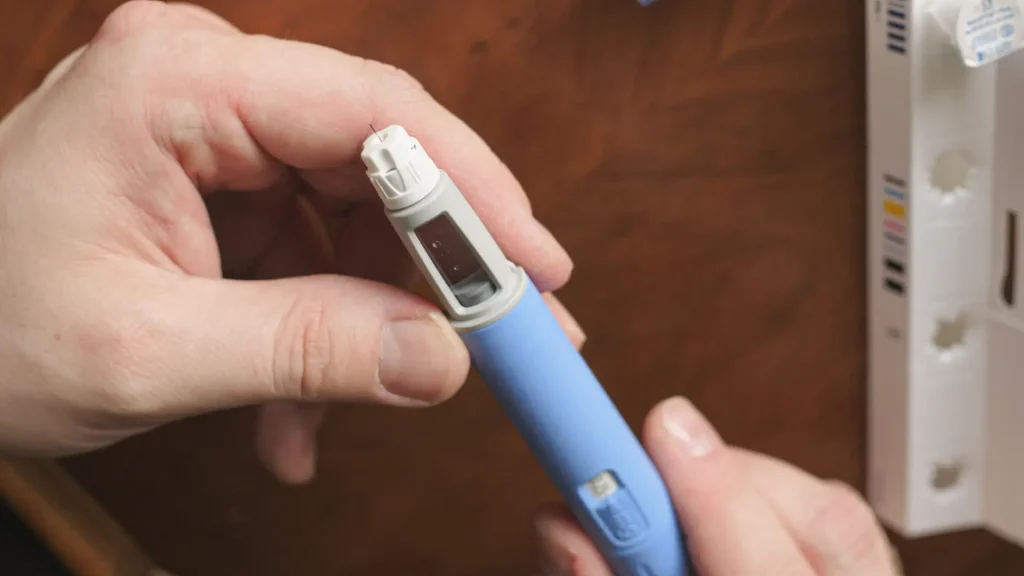
According to Ghusn et al. (2020), weekly doses of 1.7 mg and 2.4 mg of semaglutide on weight loss were associated with a degree of weight loss comparable to the results observed in randomized clinical trials. This suggests that semaglutide offers a promising option for individuals seeking effective weight management solutions.
In the face of rising concerns related to weight, such as obesity or being overweight, non-surgical interventions have emerged as effective solutions. Medical professionals often recommend injectable treatments as a viable option for managing weight issues. Among many options, Saxenda (liraglutide), Ozempic, and Wegovy (semaglutide) stand out as they deliver safe and effective options for successful weight management.
This article will compare Saxenda with other semaglutide-based alternatives for weight loss, their mechanisms of action, efficacy, safety profiles, and patient outcomes of these medications.
Key Takeaways
- Semaglutide has two roles: it produces more insulin and suppresses appetite, leading to weight loss.
- Saxenda may differ from Ozempic and Wegovy in its main ingredient, but these peptides are both used for weight loss management and type 2 diabetes.
- The studies and research have shown the safety and efficacy of these injectables; it’s worth noting that sustaining weight loss requires long-term management.
- Licensed medical professionals can purchase Saxenda, Ozempic, and Wegovy at an affordable wholesale price from the trusted online supplier Medica Depot.
- A shared and thorough consultation and decision-making process between patient and provider significantly helps maintain a safe and effective therapy for weight loss or type 2 diabetes.
About: Medica Depot is your trusted all-in-one supplier, offering a range of high-quality medical injectables and supplies. If you’re looking to buy Saxenda wholesale, our dedicated sales agents can give you proper guidance. We offer a worry-free experience in searching for the best and most popular products on the market. Whether for health professionals, plastic surgeons, dermatologists, licensed estheticians, or other specialists, we can offer genuine, brand-name products you may need. With Medica Depot, we prioritize serving you better to improve the patient’s quality of life.
Understanding Semaglutide and Its Mechanism of Action

Like liraglutide, semaglutide is a glucagon-like peptide-1 (GLP-1) receptor agonist used to treat type 2 diabetes and manage weight loss in adults. It’s found to be similar to the hormone GLP-1, modified with a side chain. Moreover, this medicine requires a doctor’s prescription; providers may administer it by subcutaneous injections or orally.
Other popular injectables, such as Ozempic and Wegovy, contain this semaglutide peptide. The mechanism of action in weight loss of semaglutide involves mimicking the action of the natural GLP-1. This peptide regulates appetite and food intake and promotes weight loss.
Activating GLP-1 receptors in the brain reduces feelings of hunger and signals individuals to feel full. This effect leads to lower calorie intake and weight loss. According to UCLA Health, semaglutide has two roles:
- It prompts the body to produce more insulin, reducing blood sugar.
- Higher amounts of GLP-1 interact with brain parts, suppressing appetite and leading to weight loss.
Comparing Saxenda, Ozempic, and Wegovy

Saxenda may differ from Ozempic and Wegovy in its main ingredient, but these peptides are both used for weight loss management and type 2 diabetes. A randomized trial in 2022 revealed that Wegovy-treated patients experienced a significant 15.8% reduction in body weight compared to Saxenda’s 6.4% in a 68-week study.
According to Medical News Today, Saxenda has been approved for weight management, while Ozempic only treats type 2 diabetes. Doctors may prescribe Ozempic off-label to help with weight loss; technically, Saxenda offers a safer solution than Ozempic because of its US Food and Drug Administration approval.
Medical professionals must discuss the safety profile and potential side effects of Saxenda, Ozempic, and Wegovy before the treatment, allowing them to make informed decisions. Their side effects are temporary and may resolve within a few days or weeks.
- Saxenda Side Effects: Nausea, diarrhea, constipation, vomiting, injection site reactions, headache, hypoglycemia, dyspepsia, fatigue, dizziness, abdominal pain, increased lipase, upper abdominal pain, pyrexia, and gastroenteritis.
- Ozempic Side Effects: Nausea, vomiting, diarrhea, abdominal pain, and constipation.
- Wegovy Side Effects: Nausea, diarrhea, vomiting, constipation, abdominal pain, headache, fatigue, dyspepsia, dizziness, abdominal distension, eructation, hypoglycemia in patients with type 2 diabetes, flatulence, gastroenteritis, gastroesophageal reflux disease, and nasopharyngitis.
Moreover, Saxenda, Ozempic, and Wegovy have specific contraindications that medical professionals should remember to ensure safe treatment for their weight loss management.
- Saxenda: Personal or family history of medullary thyroid carcinoma (MTC), hypersensitivity to liraglutide or excipients in Saxenda, and pregnancy.
- Ozempic: Personal or family history of MTC or in patients with multiple endocrine neoplasia syndrome type 2 (MEN 2) and severe hypersensitivity reaction to semaglutide or any excipients in Ozempic.
- Wegovy: Personal or family history of MTC or in patients with MEN 2 and known hypersensitivity to semaglutide or excipients in Wegovy.
The studies and research have shown the safety and efficacy of these injectables; it’s worth noting that sustaining weight loss requires long-term management. However, individual results can vary, and these medications are most effective when combined with lifestyle changes.
Clinical Trial Data and Expert Reviews
Clinical trials have shown that Saxenda, Ozempic, and Wegovy effectively manage weight loss. 83.5% of Wegovy patients lost greater than or equal to 12 lbs, while 60% of Saxenda (liraglutide) patients lost greater than or equal to 12 lbs.
Despite not having a specific indication of weight loss, a study revealed that Ozempic users lost an average of 14 lbs from their baseline weight over ten months. Furthermore, research studies show that GLP-1 receptor agonists have proven highly effective in weight loss.
However, they also highlight the importance of considering individual patient needs, potential side effects, and the necessity of lifestyle changes alongside medication.
Cost, Availability, and Patient Preference


It’s worth noting that the US Food and Drug Administration has approved Saxenda, Ozempic, and Wegovy for their respective uses for weight loss and type 2 diabetes treatment. Individuals can only use these injectables through a doctor’s prescription. Licensed medical professionals can purchase Saxenda, Ozempic, and Wegovy from the trusted online supplier Medica Depot for an affordable wholesale price.
Without insurance, the estimated one-month supply of Wegovy costs around $1,500, Saxenda at around $1,300, and Ozempic may cost $1,000. Individuals need to consult their trusted medical professionals before trying the treatment to determine which treatment suits them best and what can fit their budget constraints.
The choice between these medications often comes down to individual factors such as medical history, lifestyle, and the specific recommendations of a healthcare provider. Patients and providers may also consider other factors, such as:
- Frequency of Administration: Saxenda requires daily injections, while Wegovy and Ozempic need weekly administration.
- Primary Health Concern: Weight loss or Type 2 Diabetes
- Cost Considerations: Saxenda and Wegovy may have nearer retail prices due to their approved uses, while Ozempic has a cheaper cost.
Making Informed Decisions in Weight Loss Treatment Prescriptions
Patients must remember that Saxenda and alcohol or other medicines combined with alcohol consumption can affect the efficacy of the product. Patients and medical professionals should also consider this lifestyle factor before long-term treatment. Moreover, choosing among these options may depend on various factors:
- Individual Health Status
- Current Health Conditions
- Individual Responses to Medications
A shared and thorough consultation and decision-making process between patient and provider significantly helps maintain a safe and effective therapy for weight loss or type 2 diabetes. Providers can discuss and explain the treatment’s efficacy, potential side effects, outcome duration, and administration frequency.
Furthermore, medical professionals know each individual’s most suitable weight loss treatment. When prescribing weight loss medications, they should consider various factors, such as the medicine’s efficacy, side effects, and the patient’s comorbidities. Equipping patients with comprehensive information about the treatment allows them to make informed decisions and feel comfortable during the process.
Conclusion
As a GLP-1 receptor agonist, Semaglutide has shown efficacy in weight management and type 2 diabetes treatment. Its unique mechanism of action involves mimicking the GLP-1 hormone, resulting in weight loss. While Saxenda offers the same effectiveness, Saxenda alternatives like Ozempic and Wegovy also demonstrated significant efficacy, with Wegovy leading to weight loss results.
However, the choice of medication should be guided by a comprehensive analysis of clinical trial data, provider recommendations, cost, availability, and patient preference. Medical professionals play a crucial role in this process, ensuring that the prescribed treatment aligns with the patient’s needs and circumstances.
FAQs
1. What are the main differences between Saxenda, Ozempic, and Wegovy?
Saxenda, Ozempic, and Wegovy are all used for weight management, but Wegovy has shown a more significant reduction in body weight than Saxenda. Ozempic is primarily used to treat type 2 diabetes, and although it can be prescribed off-label for weight loss, Saxenda is specifically approved for weight management.
2. What are the common side effects of Saxenda, Ozempic, and Wegovy?
Common side effects of Saxenda include nausea, diarrhea, constipation, vomiting, and injection site reactions. Ozempic may cause nausea, vomiting, diarrhea, and abdominal pain, while Wegovy’s side effects include nausea, diarrhea, vomiting, constipation, and others.
3. What should medical professionals consider before prescribing Saxenda, Ozempic, or Wegovy?
Before prescribing these medications, medical professionals should consider the contraindications, such as personal or family history of specific conditions, and discuss each medication’s safety profiles and potential side effects. They should also emphasize the importance of long-term management and lifestyle changes for weight loss.
References
- Ghusn, W., De la Rosa, A., Sacoto, D., Cifuentes, L., Campos, A., Feris, F., Hurtado, M. D., & Acosta, A. (2022). Weight Loss Outcomes Associated With Semaglutide Treatment for Patients With Overweight or Obesity. JAMA network open, 5(9), e2231982. https://doi.org/10.1001/jamanetworkopen.2022.31982
- Colin, I. M., & Gérard, K. M. (2022). Once-weekly 2.4 mg Semaglutide for Weight Management in Obesity: A Game Changer?. TouchREVIEWS in endocrinology, 18(1), 35–42. https://doi.org/10.17925/EE.2022.18.1.35
- Novo Nordisk. Frequently Asked Questions | Wegovy® (semaglutide) injection 2.4 mg. novoMEDLINK. https://www.novomedlink.com/obesity/products/treatments/wegovy/resources/frequently-asked-questions.html
Clinical aesthetics products refer to a category of products used in the field of medical aesthetics or cosmetic dermatology. These products are typically designed and formulated to be used under the supervision of healthcare professionals, such as dermatologists, plastic surgeons, or trained aestheticians. They are distinct from over-the-counter cosmetics in that they often contain active ingredients or formulations that require expertise in their application or administration.
Examples of clinical aesthetics products include:
-
Dermal Fillers: Injectable substances used to add volume, smooth wrinkles, and enhance facial contours. Examples include hyaluronic acid fillers like Juvederm and Restylane.
-
Botulinum Toxin (Botox): Injectables that temporarily paralyze facial muscles to reduce the appearance of wrinkles caused by repetitive movements, such as frown lines and crow's feet.
-
Chemical Peels: Solutions applied to the skin to exfoliate and improve its texture. They can treat acne, pigmentation issues, and signs of aging.
-
Laser and Light Therapies: Devices that emit focused light or laser energy to treat various skin conditions, including acne, scars, and signs of aging.
-
Prescription Skincare Products: Formulations containing active ingredients like retinoids (vitamin A derivatives), hydroquinone, or prescription-strength antioxidants to address specific skin concerns under medical supervision.






